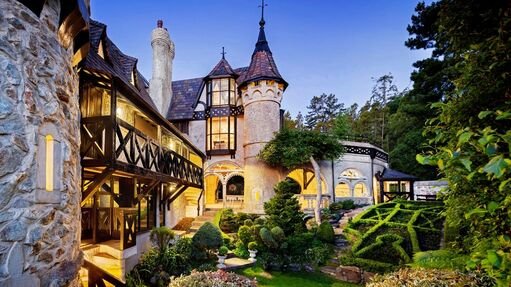Exploring the Magnificent Castles and Fortresses in Adelaide
5 months ago

Adelaide, a city renowned for its vibrant culture, stunning landscapes, and rich history, also boasts several remarkable castles and fortresses that speak to the architectural ingenuity and historical significance of the region. These stunning edifices reflect the city's colonial past, housing stories of resilience, protection, and grandeur. From the majestic structures built for nobility to the fortified buildings designed for defense, Adelaide offers a captivating glimpse into the past through its castles and fortresses.
In this extensive exploration of the castles and fortresses in Adelaide, we will delve into their rich histories, architectural features, and the events that shaped their existence. These buildings are not merely relics; they are vibrant with stories waiting to be uncovered. You will discover their significance in both the local and broader Australian context, learning how they played crucial roles in the development of the area. Join us as we embark on a journey through time, exploring the magnificent structures that make Adelaide a city filled with historical treasures.
Understanding the Historical Context of Adelaide's Castles
Before diving into the specifics of each castle and fortress in Adelaide, it's essential to understand the historical context surrounding their construction. Adelaide, founded in 1836, was planned as a free settlement, contrasting with other Australian cities that were established as penal colonies. This distinction played a significant role in the types of structures that were built. The settlers aimed to create a city that resonated with the ideals of freedom and prosperity, and the construction of castles and fortresses was part of this vision.
The period between the 1836 establishment and the late 19th century saw a wave of immigrants arriving in Adelaide, bringing with them various architectural styles and influences from Europe. Many of these immigrants were of British and European descent, which influenced the designs of the castles and fortifications. Buildings like these served multiple purposes: they were residences for the wealthy, centers of social life, and symbols of power and security. Hence, understanding this context enriches our appreciation for the castles and fortresses in Adelaide, highlighting their multifaceted roles in the city's development.
Notable Castles in Adelaide
1. Adelaide Castle: An Overview
One of the most iconic castles in Adelaide is Adelaide Castle, located on the outskirts of the city. This grand structure was designed in the Gothic Revival style, showcasing intricate stonework and elegant arches. Established in the late 19th century, it was initially built as a residence for a wealthy landowner, reflecting the prosperity of Adelaide during that time. The castle features lush gardens and ornate interiors, providing a glimpse into the lavish lifestyle of the elite settlers.
Today, Adelaide Castle is a popular tourist attraction, drawing visitors who are eager to explore its history and architectural beauty. Guided tours are available, giving guests insight into the lives of the families who inhabited the castle and the significant events that transpired within its walls. The castle's strategic location also provides stunning views of the surrounding countryside, making it a picturesque spot for photography and reflection.
2. The Influence of European Architecture
The design of Adelaide Castle and other castles in Adelaide was heavily influenced by traditional European architecture, particularly from England and France. The use of local materials combined with these European styles created a unique blend that is characteristic of South Australian architecture. Many of the castles feature ornate facades, grand entryways, and intricate woodwork that captures the elegance of the past.
Additionally, these designs aimed to reflect not only the status of the inhabitants but also their aspirations for a prosperous future in this new land. The architectural choices made by early settlers highlights their desire to create a sense of place that resonated with their heritage while also embracing the new environment. Consequently, these castles and fortresses transcend mere buildings; they are symbols of identity and belonging for the community.
Historical Fortresses in Adelaide
1. Fort Glenelg: A Defense Against Invasion
Fort Glenelg is one of the most significant fortresses in Adelaide, established in 1836 as a response to the threats perceived by early settlers. Located near the mouth of the River Torrens, it was strategically positioned to protect the settlement from potential invasions. Originally constructed as a timber fort, it was later upgraded to a stone structure, encompassing bastions and a well-fortified perimeter.
The fort played a crucial role during the tumultuous years of early settlement, serving both military and logistical needs. It housed troops and provided a sense of security for the growing population. Today, Fort Glenelg is preserved as a heritage site, attracting visitors interested in Australia's colonial military history. Guided tours offer a comprehensive experience, showcasing the fort's architecture, its role in defense, and the tales of the soldiers who once defended its grounds.
2. The Architecture of Fort Glenelg
The architecture of Fort Glenelg exemplifies 19th-century military design, characterized by robust stone walls and strategic design elements that aimed to deter any potential threats. The fortress's design included solid firing platforms and protected gates, ensuring that it could withstand attacks. These features are typical in many military fortresses in Adelaide, reflecting the fears and realities of 19th-century life.
Visitors today can witness the remnants of the fort's storied past through its preserved structures, including stores and barracks, which are essential for understanding military life in a burgeoning colony. The juxtaposition of its strong defensive architecture against the serene Adelaide coastline creates a compelling contrast, inviting reflection on the history of fortification and colonization in Australia.
Exploring More of Adelaide's Castles and Fortresses
1. The Brown Hill Creek Recreation Park
While technically not a castle, the Brown Hill Creek Recreation Park features remnants of a historical fortification, showcasing the broader context of castles and fortresses in Adelaide. The park is home to the ruins of an old stone quarry, which was integral to the construction of various buildings across the city, including some of its most notable castles. Today, the area serves as a vibrant recreational site, attracting nature lovers and history enthusiasts alike.
The connection to the city’s history is palpable as visitors wander through the park, observing the natural landscapes that once supported both industrious activities and leisurely pursuits. Throughout the park, signs provide information on the historical significance of the area, bridging the gap between Adelaide's natural beauty and the rich stories of its past. The remnants of the quarry act as a reminder of the industrious spirit that characterizes the early settlers, contributing to the infrastructure that supported the growth of Adelaide.
2. St. Peter's Cathedral: A Fortified Symbol of Faith
St. Peter's Cathedral, frequently regarded as one of the most impressive structures in Adelaide, reflects the style and spirit of the city's castles and fortresses. Although primarily a place of worship, it embodies many characteristics of fortification architecture, including its strong stone walls and imposing towers. Built in the 19th century, the cathedral’s design was inspired by English Gothic architecture, featuring pointed arches, intricate stained glass windows, and a grand façade that commands attention.
The cathedral serves not only as a space for spiritual gatherings but also as a historical landmark, offering insight into the religious landscape of early Adelaide. Its robust construction was intended to symbolize strength and resilience, paralleling the qualities found in the city's fortresses. Visitors to St. Peter's Cathedral can appreciate the melding of architectural beauty and practical design, reflecting how function and aesthetic often intertwined in the constructions of the period.
The Legacy of Castles and Fortresses in Adelaide
1. Preserving History for Future Generations
The legacy of Adelaide’s castles and fortresses extends beyond their historical and architectural significance; they serve as critical links to the city's past. As historical sites, these structures are preserved for future generations, allowing visitors to immerse themselves in the narrative of the early settlers and military personnel. Modern conservation efforts focus on maintaining the integrity of these buildings while making them accessible for education and exploration.
Through guided tours, educational programs, and community engagement, the stories associated with these castles and fortresses come alive. Schools often arrange visits to these historical sites, allowing students to grasp the complexities of Australia’s colonial history, making the past relevant and engaging. These efforts ensure that the essence of Adelaide's cultural heritage is not only preserved but actively celebrated, encouraging a deeper connection between the present and the past.
2. The Role of Castles and Fortresses in Tourism
As picturesque attractions, the castles and fortresses in Adelaide play a vital role in promoting tourism in the region. They attract visitors from around the globe, drawn to the unique blend of history, architecture, and natural beauty. Events such as reenactments, historical festivals, and guided tours are organized around these sites, enriching the tourist experience and offering insights into the lives of those who came before. This engagement creates a dialogue between tourists and locals, fostering an appreciation for the shared history and the importance of preservation.
Tourism fueled by these historical sites contributes significantly to the local economy, showcasing Adelaide as a destination for cultural exploration. Visitors often seek accommodations, dining, and other activities in the vicinity, highlighting the interdependence of tourism, history, and community development. By intertwining the stories of the past with contemporary attractions, Adelaide positions itself as a vibrant city steeped in history while embracing the charm of modern-day life.
Conclusion
The castles and fortresses in Adelaide are more than mere architectural landmarks; they are custodians of the city’s rich history and cultural heritage. From the Gothic Revival elegance of Adelaide Castle to the strategic fortifications of Fort Glenelg, each structure encapsulates powerful narratives that shaped the community. Understanding these buildings within their historical context allows us to appreciate their significance and the roles they played in the development of Adelaide as a thriving settlement.
As we explore the legacy of these majestic structures, we are reminded of the importance of preserving history for future generations. The ongoing efforts to protect and promote these sites ensure that the stories of those who came before us continue to inspire and educate. For residents and visitors alike, the castles and fortresses stand as symbols of pride, resilience, and the enduring beauty of Adelaide's heritage.

Leave a Reply